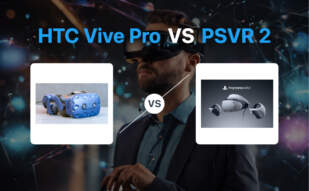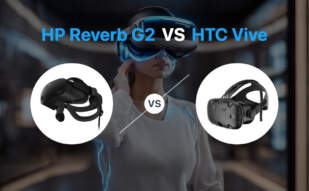HTC Vive Pro and Rift S are both high-tier VR headsets, but if cost isn’t a constraint, HTC Vive Pro, with its superior display, audio capabilities, and higher pixel density, is the right choice for professionals and enthusiasts. Conversely, Rift S offers better comfort and setup which makes it optimal for casual users.

Key Differences Between HTC Vive Pro and Rift S
- HTC Vive Pro costs $799 and Rift S costs $399.
- Vive Pro features AMOLED 3.5-inch 1440×1600 dual screens, Rift S sports an LCD 2560×1440 single screen.
- Vive Pro implements stereoscopic vision through dual cameras, while Rift S uses five cameras for precise room-scale tracking.
- Vive Pro has better pixel density (615ppi), compared with Rift S.
- Vive Pro requires additional components for operation, Rift S comes ready-to-use.
- While Vive Pro remains tethered to PC, Rift S utilizes the Oculus Insight tracking tech for immersive gaming.
- Vive Pro is an upgraded version of its precursor, whereas Rift S is viewed as Oculus’ “gold standard”.
| Comparison | HTC Vive Pro | Oculus Rift S |
|---|---|---|
| Initial Release | Announced in January 2018 | Launched in March 2019 |
| Price | $799 (without base stations & motion controllers) | $399 |
| Design & Comfort | Comfortable, secure, with built-in on-ear headphones | Comfort optimized with Lenovo designed halo headband |
| Resolution & Display | AMOLED screens – dual 3.5-inch 1440×1600 | 2560×1440 (1280×1440 per eye) |
| Refresh Rate & Viewing Angle | 90Hz refresh rate and 110-degree viewing angle | 80Hz refresh rate and 115°FOV |
| Tracking Capabilities | Dual outward-facing cameras for 3-D stereoscopic vision | 5 built-in cameras (front, top, sides) for room-scale tracking |
| Audio System | Built-in high-quality headphones, volume rocker, and mute button controls | Integrated speakers and 3.5mm Stereo headphone jack |
| Connectivity | Connects to PC through a Link Box, micro USB port, and mini DisplayPort | 5m tether cable (DisplayPort 1.2, USB 3.0) |
| Compatibility | Compatible with original Vive’s base stations and motion controllers | Compatible with Oculus Store, Viveport store, Steam VR |
| VR Experience | Improved gaming controls, sharper picture, higher resolution, and powerful audio system | Improved image clarity, reduced screen door effect, and Passthrough+ feature |
What Is HTC Vive Pro and Who’s It For?
HTC Vive Pro is a powerful virtual reality headset that embodies two years of graceful aging but still holds room for improvement. Retailing at $799, it’s an advanced version of the original HTC Vive colored in navy blue. This marvel is embraced by gaming enthusiasts and professionals chiefly for its remarkably sharper screens, hefty audio capabilities, and improved gaming controls.
The core market for the Vive Pro is players with disposable income who desire a significantly evolved VR experience. It also suits professionals dedicated to testing the limits of VR applications in industries such as training, architecture, and entertainment.

Pros of HTC Vive Pro
- Inbuilt high-quality headphones
- Increased audio and display capabilities
- Sharp screens and high pixel density
- Improved gaming controls
Cons of HTC Vive Pro
- Steep price
- Does not include necessary hardware
- Slight improvements over the original Vive
- Remains tethered to a computer
What Is Oculus Rift S and Who’s It For?
The Oculus Rift S, co-developed by Facebook Technologies and Lenovo, is an improved version of the original Oculus Rift launched in March 2019. With a price tag of $399, it positions itself as a favorite among gamers due to its Oculus Insight tracking tech and next-generation lens technology.
It’s specifically tailored for gamers, VR enthusiasts, immersive content creators, and even developers who require high-quality VR immersion. The Rift S also captures the attention of those who prioritize comfort, easy setup, and incremental upgrades in their gaming experience.

Pros of Oculus Rift S
- Increased comfort and easy setup
- High-resolution display
- ‘Inside-out’ positional tracking system
- Integrated with Oculus Store, Viveport store, and Steam VR
Cons of Oculus Rift S
- Only an incremental upgrade from the original
- Fixed lens IPD, adjustable only via software
- Ceased production in 2021
- Less mass-market appeal compared to the Oculus Quest
HTC Vive Pro vs Rift S: Pricing
While HTC Vive Pro comes with a steep price tag of $799 excluding base stations and controllers, the competitively priced Rift S is available at $399, making it a more budget-friendly option.
HTC Vive Pro
The HTC Vive Pro is priced at $799. Notably, this pricing does not factor in the base stations and motion controllers, which form a crucial aspect of the VR experience. A core bundle, however, which includes these essentials, is available for an extra $300. This brings the total cost of the full HTC Vive Pro setup to a steep $1,100, likely to dissuade casual customers and restrict the market primarily to enthusiasts and professionals.
Rift S
The Rift S, on the other hand, developed by Facebook Technologies and Lenovo, comes with a more affordable price tag of $399. The package is inclusive of all necessary gear including redesigned Oculus Touch controllers optimized for inside-out tracking. The pricing, thus, caters to those who are cost-focused, while offering an experience on par with premium VR headsets, positioning the product as a value-for-money option in the market.
The Verdict: HTC Vive Pro vs Rift S—who reigns supreme?
The VR arena is ablaze! HTC Vive Pro and Rift S go head-to-head, but who should be your champion? Let’s dissect this for different user segments.
Developers and Game Makers
If you desire maximum realism, go for the HTC Vive Pro. Its dual 3.5-inch 1440×1600 AMOLED screens with a high pixel density of 615ppi give you a sharper picture while the in-built faux-leather headphones produce powerful audio. Your senses are treated to a richly immersive VR world. However, stay mindful of the eye-watering price.

AR/VR Creators
The Rift S shines with its stellar “Insight” system which uses computer vision algorithms for precise real-time tracking, eradicating the need for external sensors. Sure, the LCD screen, while offering improved image clarity, lacks the vividness of AMOLED. Yet, for creators pushing the boundaries of AR/VR capabilities, the Rift S’s tracking tech is a game-changer.

Tech Enthusiasts with a Budget
The Rift S, priced $399, might not boast a flashy upgrade but offers solid VR experiences. The smoother interactions, sharper visuals, and superior comfort afforded by the halo headband are considerable bonuses. Do you desire a taste of VR without splurging? The Rift S is your answer.

The HTC Vive Pro dazzles with its high-resolution display and robust audio, yet its hefty price tag might dissuade many. On the other hand, the Rift S serves up a value-packed, budget-friendly VR experience, boasting innovative tracking tech. As you toss between these, let your needs and budget guide you to your perfect VR match.
Patrick Daugherty
Content writer @ Aircada. Merging AR expertise with a love for late-night gaming sessions.





